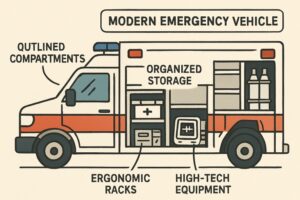Key Takeaways
- Adoption of lightweight materials enhances vehicle performance and fuel efficiency.
- Advanced safety features and ergonomic designs improve responder safety and comfort.
- Integration of smart technologies and telematics optimizes operational efficiency.
Table of Contents
- Introduction
- Lightweight Materials for Enhanced Performance
- Advanced Safety Features and Ergonomic Designs
- Integration of Smart Technologies and Telematics
- Modular Storage Solutions for Equipment Management
- Sustainable Upfitting Practices
- Future Trends in Emergency Vehicle Upfitting
Introduction
As emergency response demands evolve and technologies rapidly advance, emergency vehicle upfitting has become a cornerstone for first responder fleets. This modern approach involves reimagining and customizing vehicles with cutting-edge materials, technologies, and designs to boost safety, operational efficiency, and overall performance. Emergency vehicle upfitting is not just about adding new tools or lights—it’s a holistic transformation that shapes how first responders tackle emergencies in a safer, more effective manner.
Recent innovations have brought together lightweight construction, ergonomic considerations, integrated intelligent systems, sustainable practices, and future-forward trends, all supporting agencies in navigating today’s complex emergency landscape. With these advancements, upfitted vehicles ensure rapid deployment, fuel savings, reduced carbon footprints, and comprehensive support for first responders facing increasingly dynamic scenarios.
Lightweight Materials for Enhanced Performance
The foundation of many recent upfitting endeavors lies in the strategic shift toward lightweight materials, such as aluminum and advanced composites. By replacing traditional steel components, emergency vehicles can shed considerable weight—up to 40% in some cases—without sacrificing durability or performance. This weight reduction translates directly into improved fuel efficiency, increased payload capacities, and a smaller carbon footprint for municipal fleets. For agencies managing large numbers of vehicles, these savings quickly compound into significant operational and environmental benefits. Importantly, lighter vehicles can also accelerate faster and are generally easier to maneuver in crisis situations, helping responders reach the scene with greater speed and agility.
Advanced Safety Features and Ergonomic Designs
The evolving demands on first responder teams necessitate upfitting solutions that go beyond basic functionality. Modern designs place a premium on both safety and responder well-being. Features like ergonomic tool racks, adjustable shelving, and intuitive access points are being integrated to minimize repetitive strain and injury risk during high-stress responses. In addition, upfitters are increasingly incorporating advanced safety tools—ranging from backup cameras and blind spot monitoring systems to collision avoidance technology and high-lumen LED perimeter lighting. These capabilities help reduce accidents both en route and on scene, providing valuable safeguards in scenarios where every second and every ounce of courage matter most.
Integration of Smart Technologies and Telematics
Emergency vehicles are transforming into mobile command centers in today’s data-driven world. Real-time telematics, GPS tracking, and comprehensive fleet management software are woven into many upfitting solutions. Smart dispatch and routing systems enable agencies to coordinate responses with pinpoint accuracy and shortened response times. Predictive diagnostics and remote monitoring keep fleets ready for action by alerting technicians to maintenance needs before they become breakdowns. Telematics also supports accountability, reporting, and compliance by tracking vehicle use, driver behavior, and deployment patterns—ultimately empowering public safety leaders and fleet managers with actionable intelligence to optimize operations and prolong vehicle lifespans.
Modular Storage Solutions for Equipment Management
Effective equipment storage is a critical factor in the success of any emergency vehicle. Space is always at a premium, making modular and customizable storage solutions necessary for agencies looking to stay nimble and well-prepared. Sliding trays, adjustable racks, and secure locking mechanisms allow vehicles to be quickly reconfigured for different missions or personnel. Responders can find, secure, and deploy tools without delay, keeping vital gear protected yet always within reach. Modular storage is particularly valuable for specialized units, such as HAZMAT or SWAT teams, where mission profiles may shift rapidly and flexibility is key to operational readiness.

Sustainable Upfitting Practices
Eco-consciousness is shaping every facet of public service—including emergency response. Upfitting shops prioritize green materials, recyclable components, and energy-saving features such as LED lighting and renewable energy options like solar panel integration. These steps reduce emissions, lower energy expenditures, and provide longer operational lifespans for essential lighting and communication systems. Long-lasting LEDs alone can decrease the need for frequent replacements and cut overall energy usage, helping agencies meet community sustainability goals while lowering long-term costs for taxpayers and municipalities.
Future Trends in Emergency Vehicle Upfitting
The horizon for emergency vehicle upfitting will be shaped by ongoing advances in vehicle electrification, autonomous technology, and AI-driven systems. The anticipated shift toward electric and hybrid emergency vehicles promises dramatic long-term savings in both fuel and maintenance. Zero-idle systems, regenerative braking, and integrated battery management will improve readiness and environmental stewardship. Additionally, the integration of autonomous features may soon allow vehicles to optimize routing, avoid unforeseen hazards, and deploy equipment based on real-time data—all while keeping personnel and communities safer than ever before.
By proactively adopting these innovations, emergency response organizations position themselves to serve the public with greater agility, resilience, and impact. With comprehensive upfitting practices, agencies can transform ordinary vehicles into extraordinary assets, fully equipped to meet the evolving demands of their crucial societal roles.
